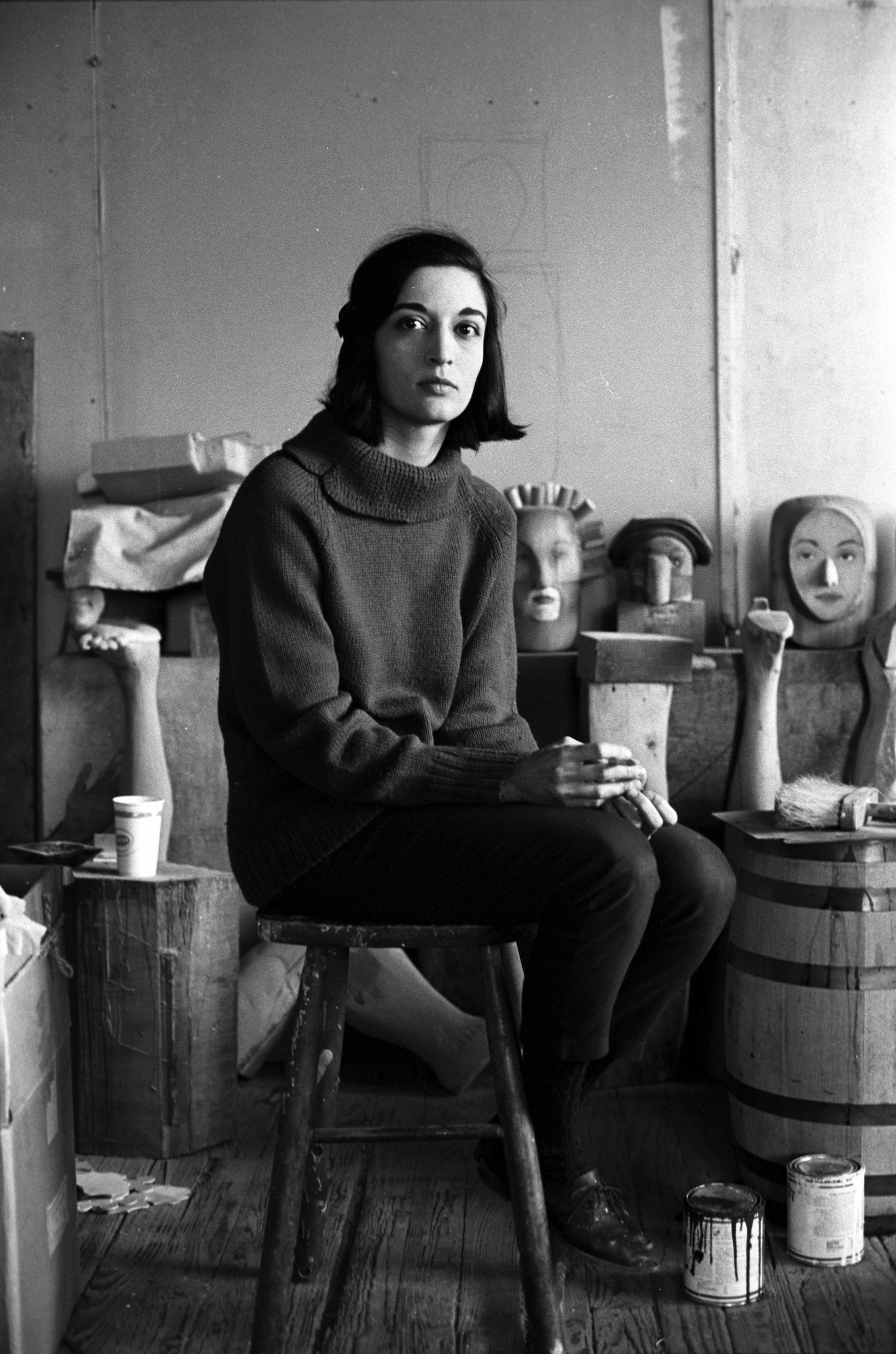
She was the toast of the town in 1960s Manhattan, but by the dawn of the next decade, Marisol had all but been forgotten.
Born in 1930 in Paris to wealthy Venezuelan parents, Maria Sol Escobar, who came to be known simply as Marisol, arrived in New York in 1950 and by the early 1960s had risen as a bright and flashing talent at the fore of the early Pop art movement.
Her piquant wooden figures with their endearingly boxy forms delighted the art world. The characters Marisol portrayed were often archetypal, women with children and families, but recognizable figures like President Kennedy, John Wayne, and the art dealer Sidney Janis also made appearances. Her work was included in the Museum of Modern Art’s 1961 “The Art of Assemblage.” She was commissioned to create three covers for TIME magazine. In 1968, she represented Venezuela at the Venice Biennale. The artist Rolando Peńa declared Marisol, in her heyday, the “undisputed queen of Pop art.”
Marisol, The Family (1963). Detail. Currier Museum of Art, Manchester, New Hampshire. Henry Melville Fuller Fund. © 2021 Estate of Marisol / Artists Rights Society (ARS), New York.
But the fame Marisol enjoyed in the 1960s shrank quickly into the shadowy corners of art history. Today, her name remains unfamiliar, particularly compared to her male contemporaries and her good friend and frequent collaborator Andy Warhol.
Marisol’s encore moment may finally be upon us, however. Last week, the Pérez Art Museum Miami opened “Marisol and Warhol Take New York” a playful and daring new exhibition that pairs the two artists’ works as parallels and counterpoints. The show originated at the Andy Warhol Museum in Pittsburgh earlier this year and was curated by Andy Warhol Museum curator Jessica Beck and organized by Maritza Lacayo of PAMM.
Narrowing its focus to the heady years of 1960 to 1968, the exhibition brings together a remarkable set of Marisol’s works from major global collections, alongside films and archival materials from the Warhol Museum. It is a testament to both artists’ friendship as well as to their shared artistic interests, and convincingly positions Marisol as an artist of equal savvy, with a cult of personality all her own.
“Somehow, [Marisol] was written into the history as a footnote, a marginal figure, when in actuality she was at the center. And not only was she at the center, but she also influenced one of the most celebrated figures in the history of the movement: Warhol,” Beck said in a statement.
Andy Warhol, Self-Portrait (1966-1967). Detail. The Andy Warhol Museum, Pittsburgh; Founding Collection, Contribution The Andy Warhol Foundation for the Visual Arts, Inc. © 2021 The Andy Warhol Foundation for the Visual Arts, Inc. / Licensed by Artists Rights Society (ARS), New York.
Warhol and Marisol met sometime in the early 1960s, and quickly became central to each other’s artistic imaginings. In 1962, Marisol made a tender sculpture of Warhol that depicts the famed artist seated in a chair, with a cast of Marisol’s own hands folded in his lap. From 1963 to ‘64, she was, in turn, a muse for him, appearing in many of his earliest experiments in film, which are on view at the museum. The strikingly beautiful Marisol intentionally cultivated a spirit of intrigue and enigma around her persona—Warhol mirrored his self-styling on her in some ways.
The pair had experienced both vastly different and harrowingly similar traumas in early life. While Warhol was born to working-class immigrant parents in Pittsburgh, Marisol was the child of wealthy Venezuelans living in Paris. Both experienced the death of a parent in childhood—Warhol of his father, and Marisol, her mother.
Certain artistic subject matter overlaps between the two as well—both make references to the Kennedys and Coca Cola. As a Venezuelan artist, however, Marisol’s handling of these themes hints at the very real political implications of American expansionism in South America. The totemic qualities of her sculptures, too, hint at Pre-Columbian traditions.
Materially, the artists were diametrically distinct; Marisol’s works are made from the hands-on process of carpentry, while Warhol’s devoted himself to silkscreening, which detached the artist’s hand.
Marisol, Dinner Date (1963). Detail. Yale University Art Gallery, Gift of Susan Morse Hilles. © 2021 Estate of Marisol / Artists Rights Society (ARS), New York.
In her own time, much attention centered on Marisol’s striking good looks and her sense of style. Warhol described Marisol as “the first girl artist with glamor.” Still, many of her works often subtly centered around the women’s experiences of caretaking and child-rearing.
Indeed, wrapped in her works, are certain feminist implications, conveyed in a language that is wholly distinct from that of male Pop artists of her era. In the most outright gesture, perhaps, the artist dropped her surname as a way of freeing herself from patrilineal associations. These aspects of her works were often lost on critics of her time.
At the height of this fame, Marisol withdrew from the limelight. When she returned to making art five years later the ground had shifted, and she never regained the stature she had earned so early on. By the time of the artist’s death at 85 in 2016, she had faded into obscurity. With “Marisol and Warhol Take New York” her talents are offered new life.